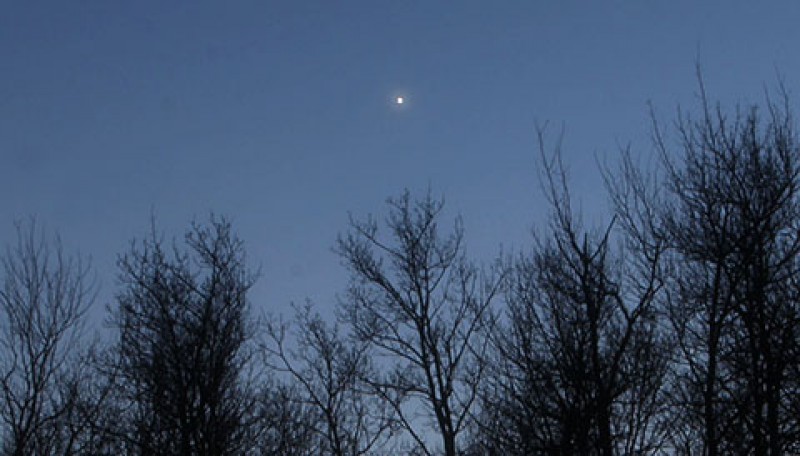Love, beauty, desire, fertility and, prosperity. These are all attributes of Venus. I would like to add another: visibility. Venus has finally returned to the evening sky after hiding in the glare of the Sun for months. It's the first bright planet to hit the evening scene since we got our last glimpse of Saturn at dusk in late November.

Not that finding Venus will be easy. At least for the next couple weeks it lurks near the western horizon at dusk. To see it you'll need to look up your local sunset time so you can begin watching for the planet 20–25 minutes later. Look for a tiny point of light punctuating the yellow-orange twilight glow. Binoculars can be a big help in tracking it down, especially if the sky's hazy.
The sooner you familiarize yourself with the planet, the better prepared you'll be when it comes to viewing the week-long tango between Venus and returning Mercury at the start of March. They'll be closest (1° apart) for the Americas on the 3rd.

During its 2018 evening apparition, Venus moves north while slowly climbing in altitude. Peak visibility will be in May and June when the planet climbs to ~20–25° after sunset for mid-northern latitudes. Venus then swings south and drops in elevation as it heads toward inferior conjunction. Greatest elongation occurs on August 17th and greatest brilliancy (magnitude –4.56) on September 25th. Venus will appear lower further north and higher up closer to the equator.
Stellarium, with additions by the author
Venus's journey to this evening apparition began on January 9th, when it was in superior conjunction on the opposite side of the Sun. Six weeks have passed since then and the planet is still 98 percent illuminated and a shimmering, white "full Moon" in a telescope. As an inner planet, it moves more rapidly than Earth (35 km/sec vs. 30 km/ sec) and slowly gains on our planet this winter and spring.

Venus takes 225 days to orbit the Sun. The planet moves to the left of the Sun now through greatest eastern elongation on August 17th, then swings back toward the Sun en route to inferior conjunction on October 26th. It repeats the sequence in reverse in the morning sky during the remainder of the year.
ESO, with additions by the author
The changing geometry between Venus, Earth, and the Sun, combined with Venus's gradual approach, cause the planet's phase to diminish but its size to grow. During the 2018 apparition, Venus will be with us through the beginning of autumn before falling back to the western horizon in early October and transitioning into the morning sky. It never gets particularly high, at least for northern hemisphere skywatchers, with a peak altitude around 20° a half hour after sunset in late spring and early summer. Closer to the equator, the planets manages nearly 35° at dusk.

Mercury joins Venus at the end of February and the first week in March. They'll be closest at just 1° apart on March 3rd when Mercury shines at magnitude –0.4 and Venus at –3.9.
Stellarium
While it's always fun to watch Venus's changing phase and size through a small telescope, seeing markings or textures in its perpetual cloud cover has always been an elusive enterprise. I've never seen anything convincing but have noted that the planet's curved edge appears brighter than the terminator region during most of its phases. I've always attributed this to the angle of the light: At the terminator, the Sun is still very low and its light grazes the clouds versus the edge, where the Sun is higher up and its light more intense.
Some observers recommend a deep blue (#38A) or violet (#47) filter to increase contrast of the clouds or reduce glare. Glare reduction is important when viewing Venus in a telescope. You can either choose a filter (I like red) or plan your observations in early twilight minutes after sundown when Venus is both highest in the sky and tamed by the solar glow.

Venus gives up much detail in its otherwise amorphous cloud cover when photographed through a UV filter, as shown here in images recorded in late 2016 by amateur Phil Miles of Rubyvale, Queensland, Australia.
Phil Miles
Clever amateur astronomers have circumvented these limitations by photographing the planet through special ultraviolet (UV) and infrared (IR) filters that transmit only a narrow slice of light. They clearly reveal the characteristic Y-shape of the planet's clouds, which are composed of droplets of sulfuric acid and cycle around the planet in four Earth days, far outpacing the planet's sluggish 243-day rotation.

The Japanese Akatsuki probe's IR2 camera acquired this recent view of the night side of Venus. Infrared energy from hot, mid-altitude clouds shows up bright, while higher clouds that block the heat appear dark. The dark saw tooth at center appears to be a turbulent boundary. The planet's sunlit crescent is overexposed at upper right. See more amazing Akatsuki images.
JAXA / ISAS / DARTS / Damia Bouic JAXA / ISIS / DARTS / Damia Bouic
Cloaked in cloud, Venus hides searing surface temperatures of 875°F (468°C), sulfuric acid rain, and an atmosphere so dense, it would crush our lungs — the result of a runaway greenhouse effect spurred by the increased heat the planet receives on account of it being so close to the Sun. In about 1.1 billion years, internal changes in our star will cause it to brighten by about 10%, enough to trigger a similar runaway on our own planet. Peering at Venus in the salmon-colored dusk, it isn't hard to transport ourselves to the distant future, when no matter what we might do today to stave off climate change, it will all be undone by the swelling Sun.
For now, put that thought out of your mind and take in the cosmetic beauty that is Venus.
Source: Bob King